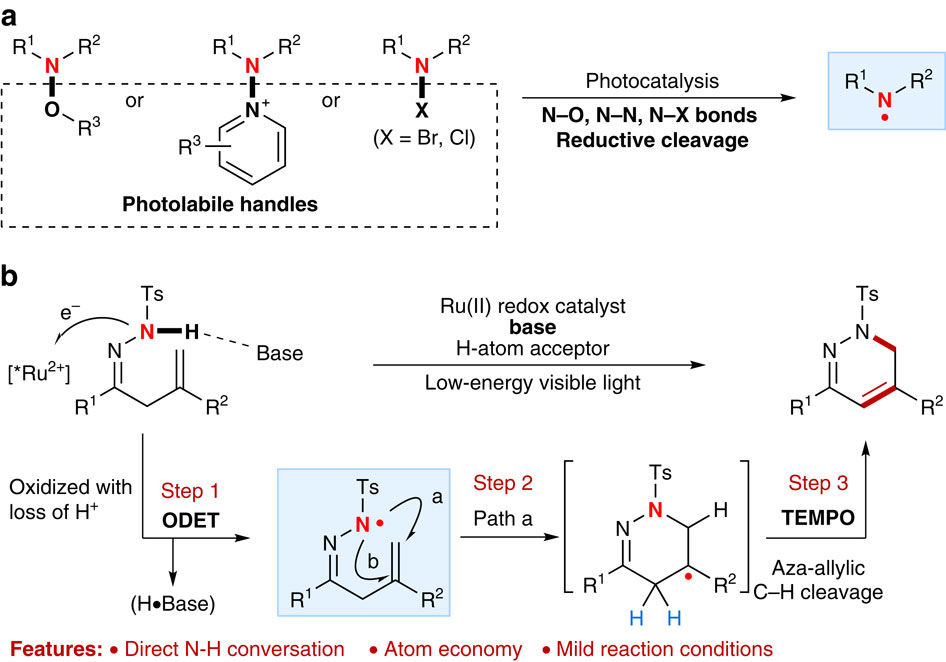当前位置:
X-MOL 学术
›
Nat. Commun.
›
论文详情
Our official English website, www.x-mol.net, welcomes your
feedback! (Note: you will need to create a separate account there.)
Catalytic N-radical cascade reaction of hydrazones by oxidative deprotonation electron transfer and TEMPO mediation.
Nature Communications ( IF 14.7 ) Pub Date : 2016-Apr-06 , DOI: 10.1038/ncomms11188 Xiao-Qiang Hu , Xiaotian Qi , Jia-Rong Chen , Quan-Qing Zhao , Qiang Wei , Yu Lan , Wen-Jing Xiao
Nature Communications ( IF 14.7 ) Pub Date : 2016-Apr-06 , DOI: 10.1038/ncomms11188 Xiao-Qiang Hu , Xiaotian Qi , Jia-Rong Chen , Quan-Qing Zhao , Qiang Wei , Yu Lan , Wen-Jing Xiao

|
Compared with the popularity of various C-centred radicals, the N-centred radicals remain largely unexplored in catalytic radical cascade reactions because of a lack of convenient methods for their generation. Known methods for their generation typically require the use of N-functionalized precursors or various toxic, potentially explosive or unstable radical initiators. Recently, visible-light photocatalysis has emerged as an attractive tool for the catalytic formation of N-centred radicals, but the pre-incorporation of a photolabile groups at the nitrogen atom largely limited the reaction scope. Here, we present a visible-light photocatalytic oxidative deprotonation electron transfer/2,2,6,6-tetramethylpiperidine-1-oxyl (TEMPO)-mediation strategy for catalytic N-radical cascade reaction of unsaturated hydrazones. This mild protocol provides a broadly applicable synthesis of 1,6-dihydropyradazines with complete regioselectivity and good yields. The 1,6-dihydropyradazines can be easily transformed into diazinium salts that showed promising in vitro antifungal activities against fungal pathogens. DFT calculations are conducted to explain the mechanism.
中文翻译:

氧化去质子电子转移和TEMPO介导的hydr的催化N自由基级联反应。
与各种C中心自由基的普及相比,由于缺乏方便的生成方法,N中心自由基在催化自由基级联反应中仍未得到充分研究。产生它们的已知方法通常需要使用N-官能化的前体或各种有毒的,潜在爆炸性或不稳定的自由基引发剂。近来,可见光光催化已经成为用于催化形成以N为中心的自由基的有吸引力的工具,但是在氮原子上预先引入光不稳定基团在很大程度上限制了反应范围。在这里,我们提出了不饱和的催化N-自由基级联反应的可见光光催化氧化去质子电子转移/ 2,2,6,6-四甲基哌啶-1-氧基(TEMPO)-介导策略。该温和的操作步骤可提供具有广泛区域选择性和良好收率的1,6-二氢吡嗪类化合物的广泛适用的合成方法。1,6-二氢吡嗪类很容易转化为重氮盐,这些重氮盐显示出对真菌病原体的体外抗真菌活性。进行DFT计算以解释该机理。
更新日期:2016-04-09
中文翻译:

氧化去质子电子转移和TEMPO介导的hydr的催化N自由基级联反应。
与各种C中心自由基的普及相比,由于缺乏方便的生成方法,N中心自由基在催化自由基级联反应中仍未得到充分研究。产生它们的已知方法通常需要使用N-官能化的前体或各种有毒的,潜在爆炸性或不稳定的自由基引发剂。近来,可见光光催化已经成为用于催化形成以N为中心的自由基的有吸引力的工具,但是在氮原子上预先引入光不稳定基团在很大程度上限制了反应范围。在这里,我们提出了不饱和的催化N-自由基级联反应的可见光光催化氧化去质子电子转移/ 2,2,6,6-四甲基哌啶-1-氧基(TEMPO)-介导策略。该温和的操作步骤可提供具有广泛区域选择性和良好收率的1,6-二氢吡嗪类化合物的广泛适用的合成方法。1,6-二氢吡嗪类很容易转化为重氮盐,这些重氮盐显示出对真菌病原体的体外抗真菌活性。进行DFT计算以解释该机理。































 京公网安备 11010802027423号
京公网安备 11010802027423号